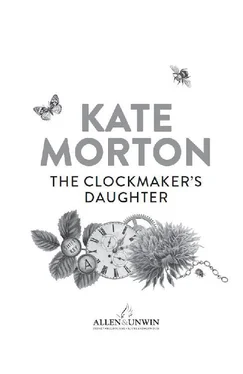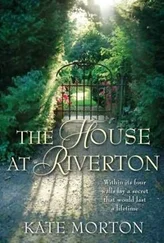Kate Morton - The Clockmaker's Daughter
Здесь есть возможность читать онлайн «Kate Morton - The Clockmaker's Daughter» весь текст электронной книги совершенно бесплатно (целиком полную версию без сокращений). В некоторых случаях можно слушать аудио, скачать через торрент в формате fb2 и присутствует краткое содержание. Год выпуска: 2018, Издательство: Allen & Unwin, Жанр: Старинная литература, на английском языке. Описание произведения, (предисловие) а так же отзывы посетителей доступны на портале библиотеки ЛибКат.
- Название:The Clockmaker's Daughter
- Автор:
- Издательство:Allen & Unwin
- Жанр:
- Год:2018
- ISBN:нет данных
- Рейтинг книги:4 / 5. Голосов: 1
-
Избранное:Добавить в избранное
- Отзывы:
-
Ваша оценка:
- 80
- 1
- 2
- 3
- 4
- 5
The Clockmaker's Daughter: краткое содержание, описание и аннотация
Предлагаем к чтению аннотацию, описание, краткое содержание или предисловие (зависит от того, что написал сам автор книги «The Clockmaker's Daughter»). Если вы не нашли необходимую информацию о книге — напишите в комментариях, мы постараемся отыскать её.
The Clockmaker's Daughter — читать онлайн бесплатно полную книгу (весь текст) целиком
Ниже представлен текст книги, разбитый по страницам. Система сохранения места последней прочитанной страницы, позволяет с удобством читать онлайн бесплатно книгу «The Clockmaker's Daughter», без необходимости каждый раз заново искать на чём Вы остановились. Поставьте закладку, и сможете в любой момент перейти на страницу, на которой закончили чтение.
Интервал:
Закладка:
‘Morning.’ Margot was boiling the kettle when Elodie arrived at work. She pulled down Elodie’s favourite mug, sat it beside her own and dropped a teabag over the side. ‘A word to the wise: he’s on the rampage this morn. The time management fellow has issued a list of “recommendations”.’
‘Oh, dear.’
‘Quite.’
Elodie took the tea to her desk, careful not to catch Mr Pendleton’s eye as she passed his office. She felt a collegial affection for her crotchety old boss, but when the mood took him he could be punitive, and Elodie had enough to get done without the assignment of a gratuitous index revision.
She needn’t have worried: Mr Pendleton was well and truly distracted, glaring blackly at something on his monitor.
Elodie settled herself at her desk and without wasting a moment transferred the sketchbook from its towelling shroud within her handbag back to the box from the disused cloakroom. It had been a temporary madness and it was over. Best thing now was to catalogue the items and assign them a place in the archives once and for all.
She donned her gloves and then took out the hole punch, the ink well, the wooden desk insert and the spectacle case. Even the most cursory of glances revealed them as mid-twentieth-century office paraphernalia; the initials on the spectacle case meant that they were safely enough recorded as having belonged to Lesley Stratton-Wood; and Elodie was glad to relax into the ease of preparing a clear contents list. She fetched a new archive box and packed the items, carefully affixing the list of contents to one side.
The satchel was more interesting. Elodie began a meticulous inspection, noting the worn edges of the leather and a number of scuffs on the back, closer towards the right-hand side; the needlework in the joins was of a very high quality, and one of the buckles bore a set of five hallmarks suggesting that it was sterling and British-made. Elodie fitted the monocle magnifying glass to her left eye and took a closer look: yes, there was the lion for sterling; the leopard for London – uncrowned, which placed the item after 1822; a lower-case ‘g’ in old English font connoting the year (a quick consultation of her London Date Letters chart revealed it as 1862); the duty mark showing Queen Victoria’s head; and, finally, the maker’s mark, a set of initials that read ‘W. S.’
Elodie consulted the directory, running her finger down the list until she reached ‘William Simms’. She smiled in recognition. The satchel had been made by W. Simms & Son, a high-end manufacturer of silver and leather goods with a Royal Warrant and, if Elodie remembered correctly, a shop situated on Bond Street.
Satisfying, but not a complete story, for the other marks on the satchel, the scuffs and patterns of wear, were of equal importance in determining its past. They showed that the satchel, no matter how exclusive its provenance, had not been purely decorative. It had been used and used well, slung over its owner’s shoulder – the right shoulder, Elodie noted, as she ran her gloved fingers gently along the unevenly worn strap – and knocked habitually against the owner’s left thigh. Elodie mimed hanging a satchel over one of her shoulders and realised that her instinct would have been to drape it in the other direction. There was a strong chance then that the satchel’s owner had been left-handed.
That ruled out James Stratton, even though his document holder had been inside the satchel; but then, the gilt initials sealed to the leather flap of the satchel had done that already. ‘E. J. R.’ Elodie traced a gloved fingertip lightly over the cursive E. The same initials were on the sketchbook. It seemed safe to assume then that the person who had made the sketches was the same person to whom the initials belonged and that this was his (or her) satchel. An artist, then? James Stratton had liaised with a number of well-known artists of the day, but the initials were not immediately familiar. There was always Google, but Elodie had an even faster line to information about art. She pulled out her phone, quelled a heart flutter as she noticed that Penelope had left a second message, and then sent a text to Pippa:
Morning! Can you think of an artist, probably mid-Vic, with the initials EJR??
The response was immediate:
Edward Radcliffe. Still on for today? Can we make it 11 instead of 12? Will text address.
Edward Radcliffe. The name was vaguely familiar, though he was not one of the artists with whom James Stratton had kept up a regular correspondence. Now Elodie typed him into Google and clicked on the Wikipedia page. The entry was brief and she skimmed the first half, noting that Edward Radcliffe’s birth year of 1840 made him a close peer to James Stratton, and that he had been born in London but spent some of his childhood in Wiltshire. He’d been the eldest of three children, the only son of a man who sounded like something of a dilettante and a woman with artistic pretensions, and had been raised for a number of years by his grandparents, Lord and Lady Radcliffe, while his parents were away in the Far East collecting Japanese ceramics.
The next paragraph described a wild youth, a fierce temper and a precocious talent, discovered by chance when an elderly artist (unfamiliar to Elodie but evidently of some renown) stumbled upon his work and took the young man beneath his wing. There had been some promising early exhibitions, a patchy relationship with the Royal Academy, a brief but fiery public spat with Dickens after a poor review; and then, finally, vindication when the great John Ruskin commissioned a painting. By all accounts, Edward Radcliffe had been on track for a distinguished career, and Elodie was just starting to wonder why she wasn’t familiar with his work, when she reached the final paragraph:
Edward Radcliffe was engaged to be married to Miss Frances Brown, the daughter of a Sheffield factory owner; however, when she was killed tragically during a robbery, at the tender age of twenty, he withdrew from public life. Rumours abound that Radcliffe was working on a masterpiece at the time; but, if so, neither the painting, nor any bona fide preliminary work, has ever seen the light of day. Radcliffe drowned off the coast of southern Portugal in 1881, but his body was returned to England for burial. Although his artistic output was not as prodigious as it might have been, Radcliffe remains an important figure in mid-nineteenth-century art for his role as a founding member of the Magenta Brotherhood.
The Magenta Brotherhood. The name rang a distant work-related bell and Elodie made a note to cross-reference it with her Stratton correspondence database. She reread the paragraph, lingering this time over the violent, untimely death of Frances Brown; Radcliffe’s withdrawal from public life; his lonely death in Portugal. Her mind stitched links of cause and effect between these points, arriving at a picture of a man whose promising career had been cut short by a broken heart and whose constitution had been weakened ultimately to the point of physical exhaustion.
Elodie took up the sketchbook and turned over its pages until she found the loose sheet containing the scrawled love note. I love her, I love her, I love her, and if I cannot have her I shall surely go mad, for when I am not with her I fear—
Was it true that there was a love so powerful that its loss could drive a person mad? Did people really feel like that? Her mind went to Alastair and she blushed, because of course to lose him would be devastating. But to be driven mad? Could she honestly imagine herself sliding into irredeemable despair?
And what if she were the one to go? Elodie pictured her fiancé in one of the immaculate bespoke suits made by the same tailor his father used; the smooth, handsome face that drew admiring glances wherever they went; the voice warmed by inherited authority. He was so assured, so clean-cut and contained, that Elodie couldn’t imagine him being driven mad by anything. Indeed, it was sobering to reflect on how quickly and quietly the gap made by her absence might close over. Like the surface of a pond after a pebble is dropped.
Читать дальшеИнтервал:
Закладка:
Похожие книги на «The Clockmaker's Daughter»
Представляем Вашему вниманию похожие книги на «The Clockmaker's Daughter» списком для выбора. Мы отобрали схожую по названию и смыслу литературу в надежде предоставить читателям больше вариантов отыскать новые, интересные, ещё непрочитанные произведения.
Обсуждение, отзывы о книге «The Clockmaker's Daughter» и просто собственные мнения читателей. Оставьте ваши комментарии, напишите, что Вы думаете о произведении, его смысле или главных героях. Укажите что конкретно понравилось, а что нет, и почему Вы так считаете.












